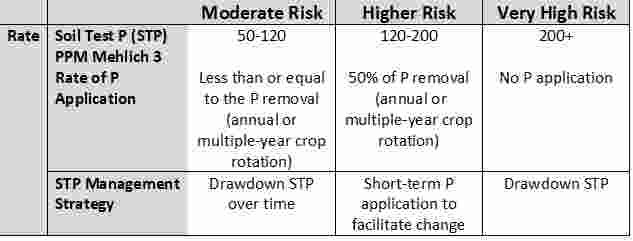By Greg LaBarge
I often get questions about managing manure applications in fields where Soil Test P (STP) is above the maintenance limit of 50 PPM in the Tri-State Fertilizer Recommendations for Corn, Soybean, Wheat, and Alfalfa, Bulletin 974. Be aware that the Tri-State Fertilizer Recommendations provide recommendations for the economical use of purchased fertilizer. The 50 PPM maintenance limit is the STP level where “no agronomic response, either higher yield or benefit of a higher STP, results from added fertilizer.” The Tri-State Fertilizer Recommendations only address crop agronomic needs, not P’s environmental impact. If you need to apply manure to a field with STP greater than 50 PPM, how can it be done to limit field P loss?
The publication Assessing Nutrient Loss Risk in Ohio, NRCS, 2020 provides environmental P loss criteria based on the STP in a field. You can download a copy at https://go.osu.edu/lossrisk. The guidelines suggest reducing manure application rates with the long-term goal of reducing STP, plus increasing the use of other conservation practices to minimize edge-of-field P losses. Table 1 shows the rate criteria for the Moderate, Higher, and Very High P-risk loss assessment classes.
Moderate: Risk 50-120 ppm Mehlich 3. Limit the manure application rate to planned crop rotation P removal. Future soil tests must show a decreasing STP. For example, a current soil test P of 80 PPM should use a manure rate and frequency that results in an STP of less than 80 ppm in the future. If the future soil test shows greater than 80 ppm result, then a lower rate or elimination of manure application should occur. In addition to close monitoring of soil test levels, other conservation practices are required. Required practices include applications to fields with >30% cover or incorporation, use of sensitive area setbacks, no surface application in spring without a growing cover, and erosion control.
Higher Risk: 120-200 ppm. Applications are to provide a limited window to facilitate operational changes, such as purchasing new fields or developing arrangements with neighboring farms to secure lower STP fields. Limit the manure application rate to 50% of planned crop rotation P removal. Required practices include applications to fields with >50% cover or incorporation, use of sensitive area setbacks, no surface application in spring without a growing cover, and erosion control.
Very High Risk: > 200 ppm. No P application. Drawdown P with a more intensive crop rotation that includes forages, if possible.
Table 1. Rate criteria from Ohio Phosphorus (P) Loss risk for Moderate, Higher, and Very High risk assessment classes. (Adapted from NRCS, 2020).

Manure is an excellent source of N, P, and K. Given the historically high fertilizer prices in recent years, it has more value in crop production than ever. However, continuing to build STP will only worsen P loss conditions in a field and the environmental pressure on manure use. The standards in Assessing Nutrient Loss Risk in Ohio, NRCS, 2020 are valuable guidelines regardless of where you are in the state or whether you do or do not participate in NRCS cost share programs
Source : osu.edu